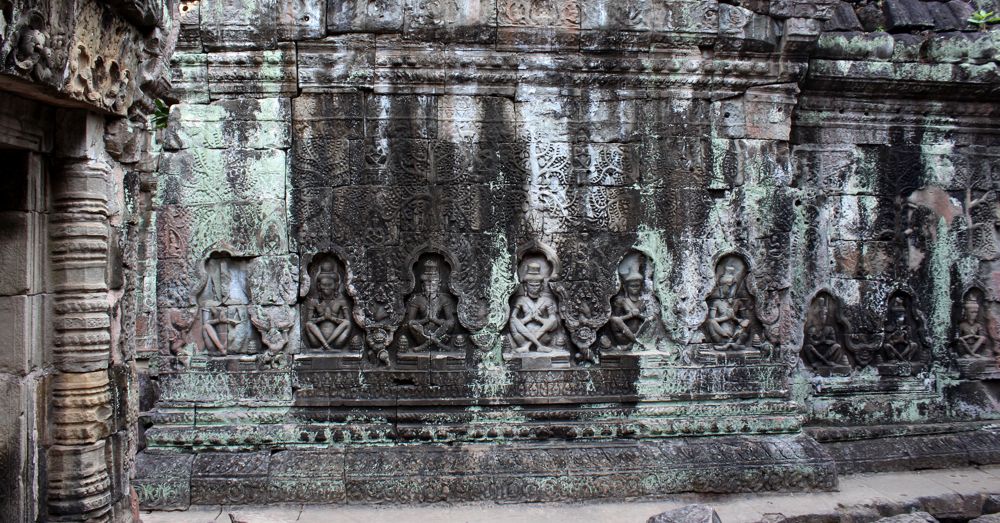Friday, 23-01-2015. Day 156.
Our Final Day of Temple Touring.
This was the last day our passes to Angkor Archaeological Park were valid, so once again we hired Dara to take us around the "Grand Tour Circuit," this time on his tuk tuk. He picked us up at 8:30 a.m. in front of the hotel, and in short order, we headed off to Angkor.
North Gate
We took the usual route into the park, past Angkor Wat and into Angkor Thom via the South Gate. But instead of stopping, we zipped on through the great city and exited via the North Gate, where we stopped to take a few photos as Dara went to get some breakfast.
Preah Khan
Not content to just build Angkor Thom, the largest city in Angkor, and Bayon, one of the largest wats, King Jayavarman VII went on to build a lot of other temples, including Preah Khan, which is only a short distance from the northern wall of Angkor Thom.
Preah Khan, which means "Sacred Sword," is built it on the site where Jayavarman VII defeated the Cham army. It is a sprawling complex that has many side chambers and hallways. A few or these have been fixed up, but most of the temple is a crumbling and worn down by time. It was a fascinating place and took us a good hour to explore as much of it as we did.
Preah Khan rests on the western shore of Jayataka Baray. A baray is a man-made body of water, and no one's quite sure if they were ceremonial or agricultural in design (perhaps both), but they're usually rectangular. This one is fairly large, more than two miles long, and in its center sits Neak Pean, out next stop of the day.
Neak Pean
Neak Pean, sits in the middle of a man-made island which sits in the middle of a man-made lake (Jayataka Baray), and to get there one must walk down a long wooden pier that stretches across the baray.
Neak Pean, which means "entwined nagas," was also built by King Jayavarman VII. It's a very simple temple, consisting of a single tower on a dais in the center of a pool, and the waterhere was renowned for their curative properties. There was a fence all around it, so we couldn't get very close to it to test out these claims.
Ta Som
Ta Som, another wat from the era of Jayavarman VII's reign, sits on the eastern edge of Jayataka Baray, opposite Preah Khan. It's smaller than Preah Khan, but in a similar state of disrepair.
One of the entrances to Ta Som is overgrown by a Ficus religiosa (better known as the sacred fig), which has significance in Buddhism—it's the tree Buddha sat under when he attained enlightenment.
East Mebon
Like Neak Peon sits in the center of Jayataka Baray, East Mebon sits in the center of the much larger East Baray, one of the largest barays in Angkor. The main difference is that East Baray dried up many years ago, so it's easy to walk right up to East Mebon..
East Mebon, bulit a few hundred years before the reign of Jayavarman VII, is dedicated to Shiva (many of the towers of the Shivaite temples are mysteriously phallic in nature). It also features a lot of sandstone elephants at the corners of the temple.
The structures inside the temple are not in the best shape. Inside the temple walls, a lot of the building are mere shells or single walls and doorways. Many of these structures are held together with wooden constructs that are starting to show their age as well. One of the ocol things about this temple, other than all the elephants, is that you can still see the landing points where boats would have moored after sailing across the baray..
Pre Rup
Pre Rup, bulit around the same time as East Mebon, was the state temple of King Rajendravarman. In fact, Pre Rup and East Mebon perfectly line up along a north-south axis,with East Mebon a little more than a kilometer to the north.
As you've probably guesses by the shape of those towers, this is another temple dedicated to Shiva. Some of the towers have grasses growing from the tops of them, and birds have made nests among the jagged rock fragments.
The temple has a few different levels and the highest level is quite a distance above the ground. The stairs to climb it are very steep and well-worn from countless tourist feet, but once at the top, you can see for a good distance in any direction. You can imagine how majestic East Baray (to the north) would have looked from this vantage point, especially in the rising or setting sun.
Banteay Kdei
Another temple from the reign of Jayavarman VII, Bantey Kdei is a smaller wat built in the style of Ta Prohm (the "Tomb Raider Temple") and Preah Khan. There are some really intricate carvings of dancers on some of its walls. Although it's in a state of deterioration, it's still used as an active temple, and there were people praying there as we explored its passageways.
Thommanon
The ladies wanted to visit their favorite temple, Thommanon, one more time. we'd visited it on our first day exploring Angkor, and they really enjoyed it. So as long as we were in the neighborhood, we stopped by so they could spend a little more time with it.
We considered revisiting Angkor Wat, but by this point in the day we were pretty tired of temples and hungry for dinner and we just wanted to get back to the hotel. So we said goodbye to Angkor Archaeological Park for the last time. As we sped out of the park, we were greeted by a whole fleet of tuk tuks heading in to the park, presumably to see Angkor Wat at sunset.

Tom Fassbender is a writer of things with a strong adventurous streak. He also drinks coffee.





















